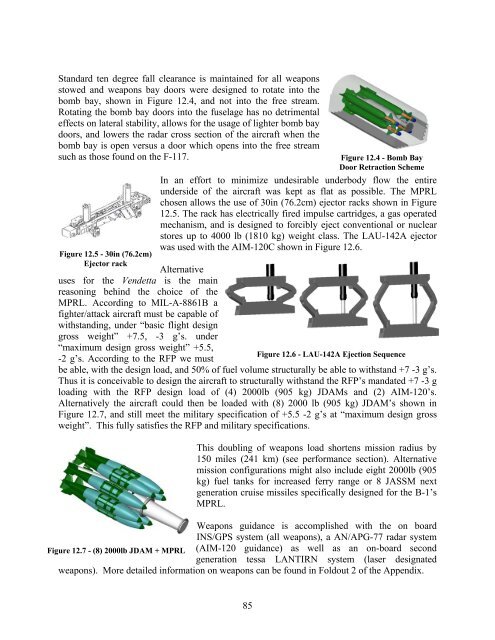SAWE Report - Cal Poly San Luis Obispo
SAWE Report - Cal Poly San Luis Obispo
SAWE Report - Cal Poly San Luis Obispo
You also want an ePaper? Increase the reach of your titles
YUMPU automatically turns print PDFs into web optimized ePapers that Google loves.
Standard ten degree fall clearance is maintained for all weapons<br />
stowed and weapons bay doors were designed to rotate into the<br />
bomb bay, shown in Figure 12.4, and not into the free stream.<br />
Rotating the bomb bay doors into the fuselage has no detrimental<br />
effects on lateral stability, allows for the usage of lighter bomb bay<br />
doors, and lowers the radar cross section of the aircraft when the<br />
bomb bay is open versus a door which opens into the free stream<br />
such as those found on the F-117.<br />
Figure 12.5 - 30in (76.2cm)<br />
Ejector rack<br />
Alternative<br />
uses for the Vendetta is the main<br />
reasoning behind the choice of the<br />
MPRL. According to MIL-A-8861B a<br />
fighter/attack aircraft must be capable of<br />
withstanding, under “basic flight design<br />
gross weight” +7.5, -3 g’s. under<br />
“maximum design gross weight” +5.5,<br />
-2 g’s. According to the RFP we must<br />
Figure 12.4 - Bomb Bay<br />
Door Retraction Scheme<br />
In an effort to minimize undesirable underbody flow the entire<br />
underside of the aircraft was kept as flat as possible. The MPRL<br />
chosen allows the use of 30in (76.2cm) ejector racks shown in Figure<br />
12.5. The rack has electrically fired impulse cartridges, a gas operated<br />
mechanism, and is designed to forcibly eject conventional or nuclear<br />
stores up to 4000 lb (1810 kg) weight class. The LAU-142A ejector<br />
was used with the AIM-120C shown in Figure 12.6.<br />
be able, with the design load, and 50% of fuel volume structurally be able to withstand +7 -3 g’s.<br />
Thus it is conceivable to design the aircraft to structurally withstand the RFP’s mandated +7 -3 g<br />
loading with the RFP design load of (4) 2000lb (905 kg) JDAMs and (2) AIM-120’s.<br />
Alternatively the aircraft could then be loaded with (8) 2000 lb (905 kg) JDAM’s shown in<br />
Figure 12.7, and still meet the military specification of +5.5 -2 g’s at “maximum design gross<br />
weight”. This fully satisfies the RFP and military specifications.<br />
This doubling of weapons load shortens mission radius by<br />
150 miles (241 km) (see performance section). Alternative<br />
mission configurations might also include eight 2000lb (905<br />
kg) fuel tanks for increased ferry range or 8 JASSM next<br />
generation cruise missiles specifically designed for the B-1’s<br />
MPRL.<br />
Weapons guidance is accomplished with the on board<br />
INS/GPS system (all weapons), a AN/APG-77 radar system<br />
(AIM-120 guidance) as well as an on-board second<br />
generation tessa LANTIRN system (laser designated<br />
weapons). More detailed information on weapons can be found in Foldout 2 of the Appendix.<br />
Figure 12.7 - (8) 2000lb JDAM + MPRL<br />
Figure 12.6 - LAU-142A Ejection Sequence<br />
85













